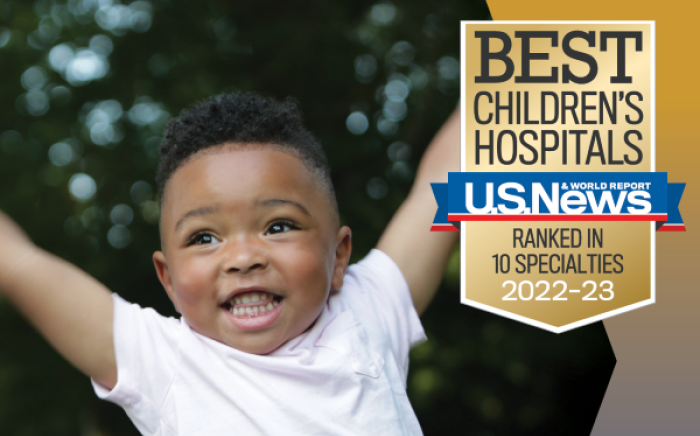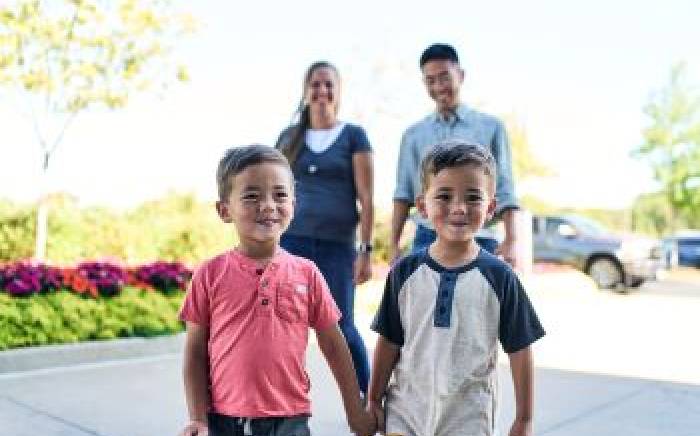Like so many expectant parents, Alana and Casey Madden were anxiously awaiting their baby’s 20 week ultrasound. But on the day of their screening—when the ultrasound technician excused herself from the room to speak to the doctor—they knew something was wrong. Further tests revealed their unborn son, Noah, had significant heart defects and Heterotaxy syndrome. The family was referred to Dr. Caroline K. Lee, pediatric cardiologist at St. Louis Children’s Hospital, for prenatal monitoring and to create a plan for labor and care after birth.
“It was very stressful,” says Noah’s dad, Casey Madden. “It was good to know ahead of time so that we could plan and prepare—but the waiting was difficult as we considered the worst- case scenarios,” says Alana. The nurse coordinator of the Fetal Care Center, handled everything for us—she coordinated all of our appointments and testing—it was one less thing we had to worry about.”
Noah’s condition was stable while in utero. It wasn’t until after he was born—when his circulation transitioned to his own heart and lungs—that his health would be in jeopardy. Of particular concern were several obstructions in the vessels leaving his lungs that could put him at risk of essentially “drowning” after birth.
 On the night Noah was born, there were at least 20 medical personnel in the delivery room.” The number one priority was to clear multiple obstructions in his pulmonary veins,” says Alana. As soon as Noah was delivered, he was rushed to the cardiac catheterization lab. “It was touch and go for a while,” says Casey. “It took five hours for the doctors to navigate through Noah’s small vessels and atypical anatomy. Dr. Lee rushed to Children’s Hospital on her night off and kept us up to date from the cath lab. Our prayers were answered when she notified us via successive texts as each obstruction was cleared.”
On the night Noah was born, there were at least 20 medical personnel in the delivery room.” The number one priority was to clear multiple obstructions in his pulmonary veins,” says Alana. As soon as Noah was delivered, he was rushed to the cardiac catheterization lab. “It was touch and go for a while,” says Casey. “It took five hours for the doctors to navigate through Noah’s small vessels and atypical anatomy. Dr. Lee rushed to Children’s Hospital on her night off and kept us up to date from the cath lab. Our prayers were answered when she notified us via successive texts as each obstruction was cleared.”
While it was good news when Noah cleared this initial hurdle; he still faced additional surgeries to repair his heart and improve circulation. For the next stage of his care, the family turned to St. Louis Children’s Hospital pediatric cardiothoracic surgeon, Dr. Pirooz Eghtesady. “Noah was diagnosed in utero with a single ventricle anomaly. This means his heart does not have the typical four chamber anatomy,” says Dr. Eghtesady, co-director of the St. Louis Children's and Washington University Heart Center. “He also had Heterotaxy syndrome –a defect that means “different arrangement” and involves the heart and other organs forming differently or being located in abnormal locations in the chest and abdomen. There was also malrotation of his intestines which often leads to twisting and blockages. These various defects require a staged approach to surgical intervention. His initial catheterization was successful, but we needed to come up with a plan for improving his circulation so he could grow and tolerate successive surgeries.”
“We had a long meeting with Dr. Eghtesady,” says Casey. “While he did not give us false hope or ‘sugarcoat’ things—his detailed explanations and caring concern gave us confidence in his ability to help our son. It was clear that Noah was in good hands.”
“We were told the first three days after his initial surgery—Total Anomalous Pulmonary Venous Return Repair and Pulmonary Artery Banding—would be critical,” says Alana. “We were amazed to see how closely Dr. Eghtesady was monitoring his condition,” says Casey. “There were a couple of times I saw him sitting by his bedside and you could see the wheels turning in his head as he weighed the options and made decisions.”
Within 17 hours, Noah went into cardiac arrest. “We were called back into his room where we witnessed Dr. Eghtesady literally holding Noah’s heart in his hand—massaging it to keep him alive,” says Casey. “It was our lowest point,” says Alana. But once again, Noah fought back and his heart began beating on its own.
Noah is now at home with his mom and dad as they watch and wait for him to gain weight and get stronger for further surgeries. “We are just taking things minute by minute and celebrating the good times. We don’t know what the future holds—but for now we are just enjoying our child and trusting in God’s plan for him,” says Alana.
“Noah, and other children with significant heart defects benefit from our multidisciplinary approach to patient care at St. Louis Children’s Hospital,” says Dr. Eghtesady. “In Noah’s case, we worked together with cardiology and the newborn medicine team to develop a thoughtful, staged approach. We looked at outcomes for similar cases and decided beforehand that we would put Noah on a heart-lung bypass machine (ECMO) to give his lungs a rest as he adapted to his new physiology. While he still had a difficult course in the hospital, this gave him the break he needed for a successful outcome for his initial surgery.”
 While this wasn’t what the family expected for their firstborn child, they are grateful for the exceptional medical care he has received. “The doctors never seem rushed—they always explained things in terminology that we could understand. And Dr. Eghtesady is just phenomenal, it is clear that he cares about Noah as a person—he’s not just a number or a statistic to him. And that means so much to us.”
While this wasn’t what the family expected for their firstborn child, they are grateful for the exceptional medical care he has received. “The doctors never seem rushed—they always explained things in terminology that we could understand. And Dr. Eghtesady is just phenomenal, it is clear that he cares about Noah as a person—he’s not just a number or a statistic to him. And that means so much to us.”









